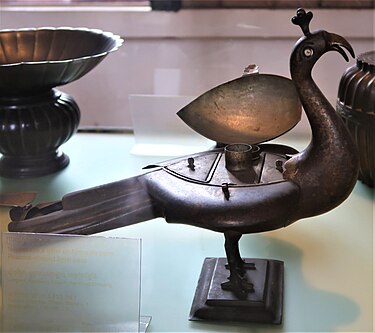
A Paan Dan or Faandan (Hindi: पान दान, Bengali: পানদান, English: Betel case) is a container for storing Paan (betel leaf) used in South Asian households. It also stores other ingredients such as zarda, supari (or gua), kattha, choona (also known as "soon"), clove, cardamom (elachi), etc. and other accessories[1]. A Paan dan is a silverware, and it was used mostly storing betel leaf, betel seeds and most other spices for making a Paan. Made of metal, the Paan dan is often perforated and has several compartments for storing the individual ingredients for making Paan.
Etymology
editThe name "Paan dan" have its own purpose, as "Paan" in Sankrit defines a combining of betel leaf with Areca nut widely consumed throughout South Asia[2] and Taiwan[3]. Whereas the phrase " Dan" is a common word used in India (Punjabi) to describe a container or a box[4]. The name " Paan dan" originated from India.
History
editThe silverware "Paan dan" was very popular during the 19th century[5]. The last ruler of the kingdom Oudh is known as Wajid 'Ali Shah' who was deposed and exiled to Calcutta by the British in 1856, also used a Paan dan to store his every day Paan's ingredients essentials. The specific Paan dan that was used by Wajid was later given to Queen Mary during the Delhi Coronation Durbar and Indian tour of 1911-1912 then presented to the museum in 1912.
Paan dan is carried by everyone during the old days. Even the dancing girls of the court of Nawabs in Lucknow carries it, its discovered that the dancing girl's Paan dan's material includes pure silver, coated with fine Mughlai ( a local oil used to reserve metal and silver from resulting) work of Lucknow[6].
In the old days, Betel leaf and its seeds are usually consumed by field workers and other rural inhabitants. People chew it to suppress their hunger as it is mild painkilling effects are the same as a narcotic.
Weight and Measures
editThe standard length of a Paan dan usually varies the height: 3.93 inches, with a width of 10.43 inches and a length of 7 inches approximately. It usually weighs around 2 pounds[7].
Production
editEvery design of a Paan dan is handcrafted by an artist and every Paan dan have its own characteristic as to represents its individuality, and uniqueness[8]. A Paan dan can be a custom craft to satisfy the customer's taste and usually has different appearances due to the customer's personality. Every silverware that are crafted by local craftspeople usually left a mark or two under their Paan dan as a signature of their product. A Paan dan is usually crafted out with pure silver and covered with local oil to refrain the silverware from rusting.
Modern Use
editNowadays, people still use Paan dan to store their betel leaves and seeds[8]. As time went by, the majority of people in local areas gave up on chewing betel leaf, which results in a situation where artisans have a tough time to weather continue to crafts their masterpiece which represents their own culture or to give up on it. Since a decline rate of people has given up the culture of handing out Paan dan during a wedding ceremony, the existence of Paan dan is in question. Local craftspeople are worrying since youngsters are not interested in learning to craft a Paan dan as it will not pay much, which only is popular during Ramadan.
Aside from consuming bland betel leaves, people also consume Paan as they wrap those seeds with betel leaf which are flavored with lime paste[9]. Paan has many benefits as it is used for painkilling effects and also used as a laxative and promotes digestion.
References
edit- ^ "Vintage Oval Brass Paan Dan, Beetle Nut Box, Handcrafted Box With 6 Compartments, Home Decor, Condiments Box, L19 cm x W 13 cm x H 9 cm". Etsy. Retrieved 2019-10-31.
- ^ Auluck, A; Hislop, G; Poh, C; Zhang, L; Rosin, MP (2009). "Areca nut and betel quid chewing among South Asian immigrants to Western countries and its implications for oral cancer screening". Rural and remote health. 9 (2): 1118. ISSN 1445-6354. PMC 2726113. PMID 19445556.
- ^ "Paan | Definition of Paan by Lexico". Lexico Dictionaries | English. Retrieved 2019-10-31.
- ^ ATKINSON, John Christopher (1868). A Glossary of the Cleveland Dialect: explanatory, derivative, and critical. J. R. Smith.
- ^ "Pan dan (casket for betel) (Pan dan (casket for pan)) | V&A Search the Collections". V and A Collections. 2019-10-31. Retrieved 2019-10-31.
- ^ "Paan Dan". indiamart.com. Retrieved 2019-10-31.
- ^ "Pan box (Paan dan)". gettysburg.contentdm.oclc.org. Retrieved 2019-10-31.
- ^ a b Khan, AuthorAsif Yar. "Hyderabad: Changing traditions make lives of paandaan makers tough". Telangana Today. Retrieved 2019-10-31. Cite error: The named reference "Khan" was defined multiple times with different content (see the help page).
- ^ Reddy, Kovuuri G. (2015). Handbook of Journalism and Media: India, Bharat, Hindustan. Vikas Publishing House. ISBN 9789325982383.
